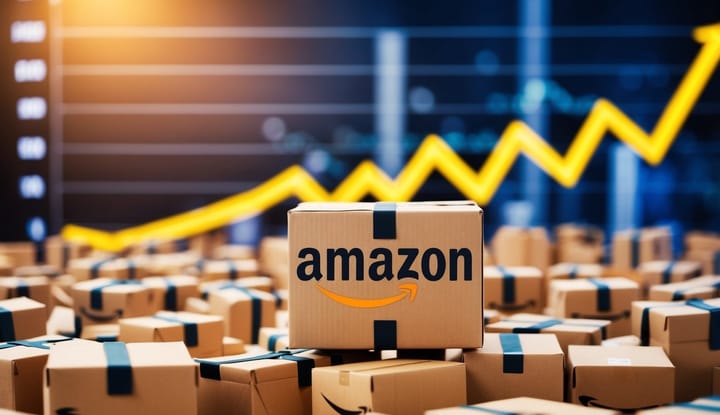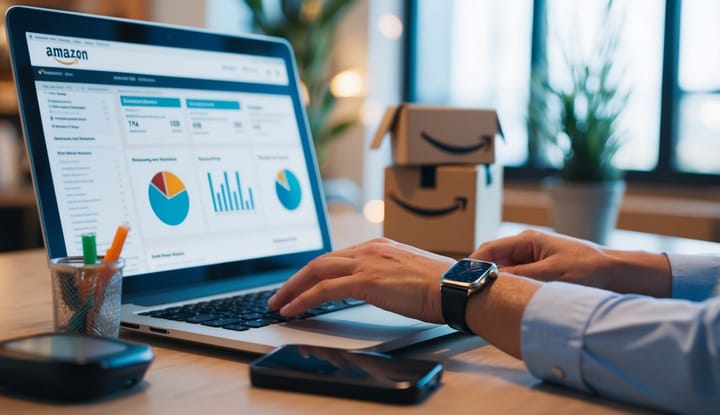FBA Growth Weapon: Power Up with Influencer Marketing

Selling on Amazon FBA requires more than just listing products and hoping for sales. Smart sellers use influencer marketing to reach new customers and build brand trust. Amazon's Influencer Program connects FBA sellers with social media creators who showcase products to their engaged followers, leading to increased visibility and sales.

Working with influencers gives Amazon sellers access to ready-made audiences who trust their favorite content creators' recommendations. These partnerships create authentic product demonstrations and reviews that help potential customers make informed buying decisions.
The most successful Amazon FBA sellers combine influencer marketing with their existing promotional strategies. This approach creates multiple touchpoints for potential customers and helps products stand out in Amazon's crowded marketplace.
Key Takeaways
- Amazon's Influencer Program connects sellers with content creators to expand product reach and boost sales
- Social media influencers provide authentic product demonstrations that build customer trust
- Strategic influencer partnerships create multiple customer touchpoints across different platforms
Understanding Amazon FBA Influencer Marketing
Amazon FBA sellers can leverage social media influencers to promote products, build brand awareness, and drive sales through authentic content creation and targeted audience reach. The strategy connects trusted voices with potential customers through genuine product recommendations.
What Is Amazon FBA Influencer Marketing?
Amazon FBA influencer marketing pairs sellers with content creators who have engaged followers on social media platforms. These influencers create authentic content featuring Amazon products while sharing their personal experiences.
The influencers must join the Amazon Influencer Program to get their own storefront page. This page displays their recommended products and helps track sales performance.
Social media creators showcase products through various content types like:
- Product reviews and unboxing videos
- How-to tutorials and demonstrations
- Lifestyle content featuring the products
- Shopping hauls and favorites lists
Benefits of Influencer Marketing for Amazon Sellers
Influencer partnerships create social proof and boost product credibility through trusted recommendations. This leads to higher conversion rates compared to traditional advertising.
Working with influencers helps reach targeted audiences who match ideal customer profiles. Their followers often share similar interests and buying habits.
Key advantages include:
- Increased brand visibility across multiple social platforms
- Enhanced product trust through authentic reviews
- Access to niche markets and engaged communities
- Fresh content creation for marketing materials
- Improved search rankings from increased traffic and sales
Key Differences Between Amazon Influencer Program and Affiliate Marketing
The Amazon Influencer Program offers dedicated storefronts where creators can showcase multiple products. Regular affiliates only get individual product links.
Influencers must meet specific requirements:
- Established social media presence
- Engaged follower base
- Quality content creation skills
- Regular posting schedule
The program provides detailed analytics and sales tracking tools. This helps both sellers and influencers measure campaign success and adjust strategies.
Influencers earn higher commission rates than standard affiliates. They also get access to exclusive promotional opportunities and early product releases.
Developing an Effective Influencer Marketing Strategy
A strategic influencer marketing plan helps Amazon FBA sellers connect with the right creators and reach their target customers. Success requires clear goals, authentic brand messaging, and smart platform choices.
Defining Goals and Target Audience
Start by setting specific, measurable marketing objectives. Common goals include increasing brand awareness, driving sales, or launching new products.
Research target customer demographics like:
- Age range
- Location
- Income level
- Shopping habits
- Pain points
- Product preferences
Create detailed buyer personas based on this data. These profiles help match influencers to the right audience segments.
Track key metrics that align with goals:
- Engagement rates
- Click-through rates
- Conversion rates
- Sales attribution
- Return on investment
Identifying Your Brand Values and Messaging
Brand values shape influencer partnerships and content direction. Define core principles that resonate with target customers.
Focus messaging on solving customer problems and meeting needs. Keep language simple and benefits clear.
Create brand guidelines for influencers that include:
- Voice and tone
- Key talking points
- Product features to highlight
- Visual style requirements
- Mandatory disclosures
Choosing the Right Social Media Platforms
Select platforms where target customers spend time. Different channels suit different content types and audiences.
Instagram works well for visual product showcases and lifestyle content. TikTok reaches younger audiences with short-form videos.
Match content format to platform strengths:
- Instagram: Photos, Stories, Reels
- YouTube: Detailed reviews, tutorials
- TikTok: Creative short videos
- Pinterest: Product inspiration
- Facebook: Community building
Test engagement across platforms to find the best performing channels.
Selecting and Partnering with Influencers
Choosing the right influencers and creating mutually beneficial partnerships requires careful evaluation of engagement metrics, niche alignment, and fair compensation structures. A strategic selection process leads to more authentic product promotions and better returns on investment.
Finding Ideal Influencers for Your Niche
Amazon influencers with established personalized storefronts make strong potential partners. These creators already understand the Amazon ecosystem and have built trust with their followers.
Look for influencers who naturally align with your product category. A beauty influencer makes sense for skincare products, while a tech reviewer fits better for electronics.
Key factors to consider:
- Content quality and consistency
- Audience demographics
- Platform presence (Instagram, YouTube, TikTok)
- Previous Amazon promotion experience
Evaluating Engagement Metrics and Authenticity
Real engagement matters more than follower count. Check these key metrics:
- Comment-to-like ratios
- View-to-engagement rates
- Audience growth patterns
- Content sharing frequency
Watch for red flags like sudden follower spikes or generic comments that could signal fake engagement. Review past sponsored content to see how the influencer presents products.
Quality influencers maintain consistent interaction with their audience and respond genuinely to comments.
Negotiating Commission Rates and Bounties
Standard commission rates range from 5-15% for most product categories. Higher-priced items often warrant lower percentage rates.
Common compensation structures:
- Fixed commission per sale
- Tiered rates based on volume
- One-time posting fees
- Performance bonuses
Set clear expectations about posting frequency, content requirements, and tracking methods. Put all terms in writing, including payment schedules and exclusivity clauses.
Consider offering special bounties for exceeding sales targets or maintaining long-term partnerships.
Content Creation and Promotion Strategies

Effective content strategies for Amazon FBA sellers focus on authentic product promotion, optimized listings, and strategic use of social media platforms to reach target customers and boost sales.
Leveraging Product Recommendations and Honest Reviews
Creators must share genuine experiences with products through detailed video demonstrations and clear explanations of features and benefits.
Product reviews should highlight specific use cases and practical applications that resonate with the target audience.
Including both pros and cons in reviews builds trust with potential customers and increases credibility. This balanced approach typically leads to higher conversion rates.
Key elements for authentic content:
- Detailed product demonstrations
- Real-world usage scenarios
- Clear feature explanations
- Transparent pros and cons
Optimizing Amazon Storefronts and Product Listings
A well-designed Amazon storefront needs clear navigation, professional images, and consistent branding elements.
Product listings must include high-quality photos from multiple angles and detailed bullet points highlighting key features.
Essential optimization elements:
- Keyword-rich titles
- Clear product descriptions
- High-resolution images
- Mobile-friendly layout
- Brand story integration
Driving Traffic and Increasing Conversion Rates
Social media posts should direct followers to optimized product pages through trackable affiliate links.
Creating urgency through limited-time deals and exclusive discount codes can boost conversion rates.
Traffic generation tactics:
- Strategic posting schedules
- Platform-specific content
- Targeted hashtag usage
- Engaging call-to-actions
Utilizing Amazon Live and Social Media Presence
Amazon Live streams allow real-time product demonstrations and direct audience interaction. Sellers should schedule regular streaming sessions during peak shopping hours.
Cross-platform promotion helps reach diverse audience segments. Each platform requires unique content formats:
- Instagram: Short-form videos and Stories
- TikTok: Trending challenges and demos
- YouTube: In-depth reviews
- Pinterest: Product photography
Consistent posting schedules and engagement with followers help build a loyal community around the brand.
Measuring Success and Building Trust

Successful influencer marketing on Amazon FBA requires careful tracking of key metrics and building genuine connections with customers through transparent practices and authentic reviews.
Tracking Engagement and Conversion Metrics
Sales conversion rate is a crucial metric that shows the percentage of influenced visits that result in purchases. Track click-through rates from influencer content to product listings.
Monitor these key performance indicators:
- Click-through rate (CTR) from influencer posts
- Add-to-cart rate
- Sales conversion percentage
- Return on ad spend (ROAS)
Use Amazon's Brand Analytics to measure search rank improvements and market basket analysis. Set up unique tracking links for each influencer to measure their individual performance.
Encouraging Authenticity and Transparency
Influencers must clearly disclose their partnerships with Amazon FBA brands. Provide them with accurate product information and samples for honest reviews.
Let influencers maintain creative freedom in their content creation. Their authentic voice resonates better with followers than scripted promotions.
Create detailed campaign briefs that include:
- Product features and benefits
- Target audience demographics
- Brand values and guidelines
- FTC disclosure requirements
Utilizing Customer and Amazon Reviews
Product reviews serve as social proof for potential buyers. Encourage satisfied customers to leave detailed feedback about their experience.
Monitor review trends to identify common praise or concerns. Address negative feedback promptly and professionally.
Leverage positive reviews in marketing materials:
- Screenshot 5-star reviews for social proof
- Share customer success stories
- Highlight specific product benefits mentioned in reviews
Request feedback from customers who purchased through influencer links to measure campaign impact on customer satisfaction.
Scaling and Optimizing Your Influencer Campaigns

Smart scaling of influencer campaigns requires careful attention to inventory levels, audience targeting, and platform changes. Success comes from managing these elements while maintaining profitable partnerships.
Managing Inventory for Influencer Promotions
Amazon Seller Central provides tools to track stock levels and predict demand spikes from influencer promotions. Sellers should maintain at least 3x their normal inventory when running campaigns.
Setting inventory alerts and reorder points helps prevent stockouts during high-traffic promotional periods. Many sellers use automated inventory management systems to adjust stock levels based on influencer posting schedules.
Creating backup supplier relationships gives flexibility when products gain sudden popularity. Smart sellers negotiate payment terms that align with influencer promotion schedules.
Expanding Into New Niches and Audiences
Testing new product categories with micro-influencers reduces risk while exploring market potential. Start with 2-3 influencers per niche to measure audience response.
Track engagement metrics and sales data to identify which audience segments convert best. Focus on niches where products solve specific customer problems.
Use Amazon's targeting tools to reach similar audiences that match successful campaigns. Build relationships with influencers who have followers in multiple related niches.
Adapting to Algorithm Changes and New Features
Monitor Amazon's algorithm updates through Seller Central announcements. Adjust product listings and keywords to maintain visibility as ranking factors change.
Test new promotional features like Amazon Live and Stories when they launch. Early adoption often leads to better placement and results.
Stay current with platform rules about influencer disclosures and promotional content. Regular testing of different content formats helps identify what drives the most sales.
Frequently Asked Questions

Common questions about Amazon FBA influencer marketing focus on campaign strategies, program mechanics, and measuring success through key metrics like engagement and sales conversion rates.
Q: How can sellers effectively incorporate influencers into their Amazon FBA marketing campaigns?
FBA sellers should start by identifying influencers whose audience matches their target market demographics.
A successful campaign requires clear objectives, timelines, and measurable goals tied to specific product promotions.
Sellers need to provide influencers with detailed product information, high-quality images, and unique discount codes to track performance.
Q: What are the essential elements of a successful influencer marketing strategy for Amazon FBA?
A strong strategy begins with selecting the right product categories and price points for influencer promotion.
Clear communication guidelines and content requirements help maintain brand consistency across all influencer posts.
Regular performance tracking through Amazon's analytics tools helps optimize campaign effectiveness.
Q: Can you describe the operational process of the Amazon Influencer Program for FBA sellers?
The program connects FBA sellers with approved influencers who have established social media followings.
Influencers create custom storefronts featuring recommended products and earn commissions on qualifying sales.
Sellers ship products to Amazon warehouses while influencers handle content creation and promotion.
Q: What are the benefits of using a free influencer search tool for Amazon FBA marketing?
Free search tools help identify relevant influencers based on niche markets and engagement metrics.
These platforms often provide data about audience demographics and past campaign performance.
Q: How does ROI for influencer marketing on Amazon FBA compare to other marketing strategies?
Influencer marketing typically shows higher engagement rates compared to traditional advertising methods.
Tracking tools measure direct sales impact through custom URLs and promotion codes.
The cost per acquisition tends to decrease as influencer relationships strengthen over time.
Q: What best practices should be followed when choosing influencers for Amazon FBA promotions?
Analyze engagement rates and audience authenticity rather than focusing solely on follower count.
Review past sponsored content to ensure the influencer maintains professional standards.
Request performance metrics from previous Amazon promotions before finalizing partnerships.
Q: What is amazon influencer marketing?
Amazon influencer marketing is a strategy where influencers promote products from your Amazon store, helping to drive sales and increase brand awareness through their engaged audiences.
Q: How can I find the right influencer for my amazon business?
To find the right influencer for your Amazon business, look for individuals who align with your brand values, have an audience that matches your target customers, and create engaging content that resonates with your products.
Q: How does amazon influencer marketing work?
Amazon influencer marketing works by having influencers share links to your products, often through their social media platforms or Amazon influencer storefronts, allowing them to earn a commission on sales generated through their promotional efforts.
Q: Can I use tiktok for my influencer marketing campaigns?
Absolutely! TikTok is a powerful platform for influencer marketing campaigns, as its short, engaging videos can help drive sales and boost brand awareness quickly.
Q: What types of content should influencers create to drive sales for my amazon store?
Influencers should create engaging content that showcases your products in use, shares personal experiences, and highlights unique features, making their followers more likely to make purchasing decisions.
Q: How do I measure the success of my influencer marketing campaigns?
You can measure the success of your influencer marketing campaigns by tracking metrics like referral traffic to your Amazon store, sales generated, and engagement levels on the influencer's posts.
Q: What are some common mistakes when working with amazon influencers?
Common mistakes include not clearly defining campaign goals, choosing influencers who don’t align with your brand, or failing to communicate effectively throughout the partnership.
Q: How can I harness the power of influencer marketing for my Amazon FBA business?
To harness the power of influencer marketing for your Amazon FBA business, collaborate with influencers who can authentically promote your products, create compelling campaigns, and strategically leverage their reach to boost your marketing efforts.
Q: What is an influencer marketing guide and why do I need one?
An influencer marketing guide is a resource that provides tips and best practices for running successful campaigns. It helps you understand how to select influencers, create engaging content, and effectively measure outcomes, making it essential for your Amazon business strategy.
Q: Do I need to pay influencers to promote my products on Amazon?
While some influencers may work for free products or shoutouts, many expect compensation for their work. It's common to set up a payment structure where influencers earn a commission on sales or a flat fee for their promotions.
Ready to Boost Your FBA Sales with Influencers?
Learn how to use influencers the right way. Our mini-course at WAH Academy will show you how to connect with creators, boost visibility, and drive real results through the Amazon Influencer Program.
No hype. No fluff. Just clear steps to grow faster with the right partners.
Tap the button and start scaling with influencer marketing today.



